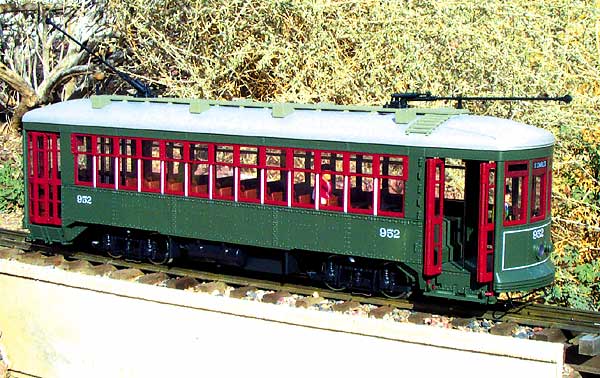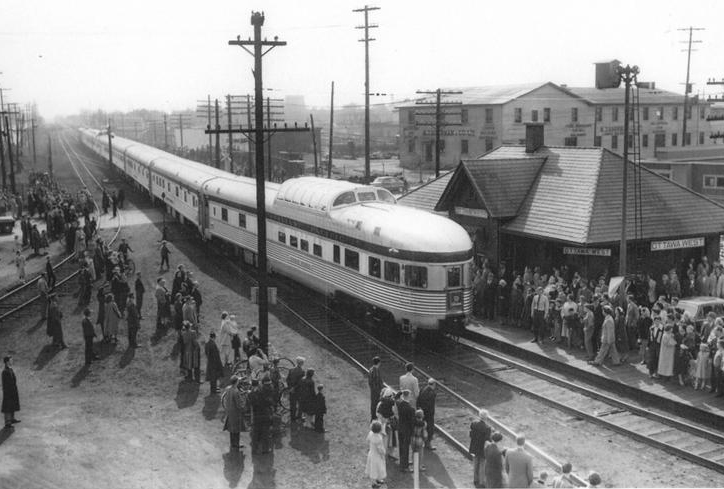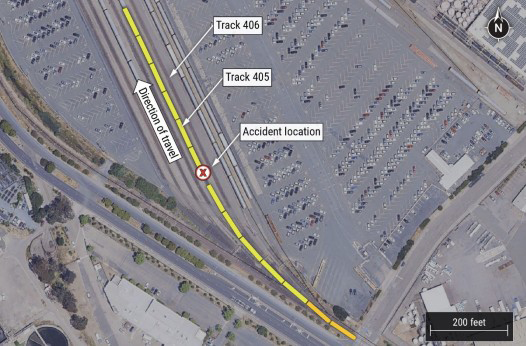Gauge-1 streetcar
LGB of America
6444 Nancy Ridge Drive
San Diego CA 92121
Price: $539.99
Web Site: www.lgb.com
All-plastic model of a Perley Thomas, 900-series, New Orleans streetcar; two powered trucks; opening door and fold-down steps; complete interior; lighted interior; one driver and two passengers included; directional lighting; 12 power-pickup points; sticker sheet with additional car numbers and destinations included; LGB MTS decoder built in; digital or analog operation. Length, 21″; width, 4 3/8″; height (above lowered pole), 6 5Ú8″
Pros: Good representation of a classic American streetcar; excellent paint and graphics; authentic colors; high level of detail; opening doors and fold-down steps; interior lights; lighted destination signs; excellent operational characteristics; realistic top speed
Cons: Ambiguous scale; unsprung, non-functional trolley poles; motor blocks extend into interior space, interfering with interior detail; doors don’t stay closed very well in operation; rewiring for overhead operation difficult
LGB’s representation of the streetcar has many nice features. It is fully illuminated, inside and out, with directional lighting. The destination signs are also lit. The doors open prototypically while the steps simultaneously fold down. Unfortunately, the doors would prefer to be open, it seems, as they come open of their own accord while the streetcar is in motion. There are windows all around in the correct number, allowing a full view of the car’s interior. The motor blocks on the trucks are quite tall, though, and space had to be made inside the car for them. Thus, the floor at either end of the car is at seat level, making the seats suitable only for amputees, a couple of which are thoughtfully provided as passengers. A complete set of controls and a motorman’s chair are supplied at each end of the car, with a motorman at one end. The car rides on correct-pattern trucks, as well.
The car is prorotypically painted olive green, with boxcar-red windows and doors, a gray roof, and white trim. Lettering is crisp and opaque. A sticker sheet is provided that includes enough car numbers for eight cars (both 800s and 900s) and a similar number of destinations and route numbers. (Interestingly, No. 952, which is modeled here, does not live in New Orleans any more-it is part of San Francisco’s vintage streetcar collection.)
One drawback is the fact that the trolley poles are all plastic, unsprung, and purely ornamental. They sort of clip in position, either up or down. Their replacement with functional metal poles would be an asset, although rewiring the car for overhead operation would be difficult.
That said, though, the operation of the car off track power is excellent. Slow speeds are all one could ask for and the top speed is a reasonable (estimated) 45 mph or so. Rapid acceleration and deceleration is easy, and the car looks great, both cruising through the countryside or operating in an urban setting. Tight corners are no problem, either. LGB has equipped the car with its digital MTS decoder, so it is ready to go if you are using that system. If not, it runs perfectly well with a standard power pack. If you are using digital control, a half dozen or so of these cars would make a fine model streetcar system, each car being independently controlled.
I have had the pleasure of riding New Orleans’ streetcars several times, and LGB’s model certainly captures the essence of them. It is a good looking product that operates flawlessly.














